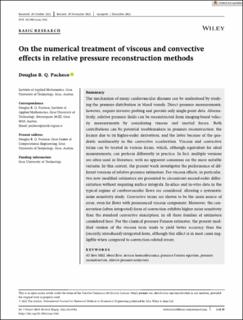| dc.description.abstract | The mechanism of many cardiovascular diseases can be understood by studying the pressure distribution in blood vessels. Direct pressure measurements, however, require invasive probing and provide only single-point data. Alternatively, relative pressure fields can be reconstructed from imaging-based velocity measurements by considering viscous and inertial forces. Both contributions can be potential troublemakers in pressure reconstruction: the former due to its higher-order derivatives, and the latter because of the quadratic nonlinearity in the convective acceleration. Viscous and convective terms can be treated in various forms, which, although equivalent for ideal measurements, can perform differently in practice. In fact, multiple versions are often used in literature, with no apparent consensus on the more suitable variants. In this context, the present work investigates the performance of different versions of relative pressure estimators. For viscous effects, in particular, two new modified estimators are presented to circumvent second-order differentiation without requiring surface integrals. In-silico and in-vitro data in the typical regime of cerebrovascular flows are considered, allowing a systematic noise sensitivity study. Convective terms are shown to be the main source of error, even for flows with pronounced viscous component. Moreover, the conservation (often integrated) form of convection exhibits higher noise sensitivity than the standard convective description, in all three families of estimators considered here. For the classical pressure Poisson estimator, the present modified version of the viscous term tends to yield better accuracy than the (recently introduced) integrated form, although this effect is in most cases negligible when compared to convection-related errors. | en_US |

